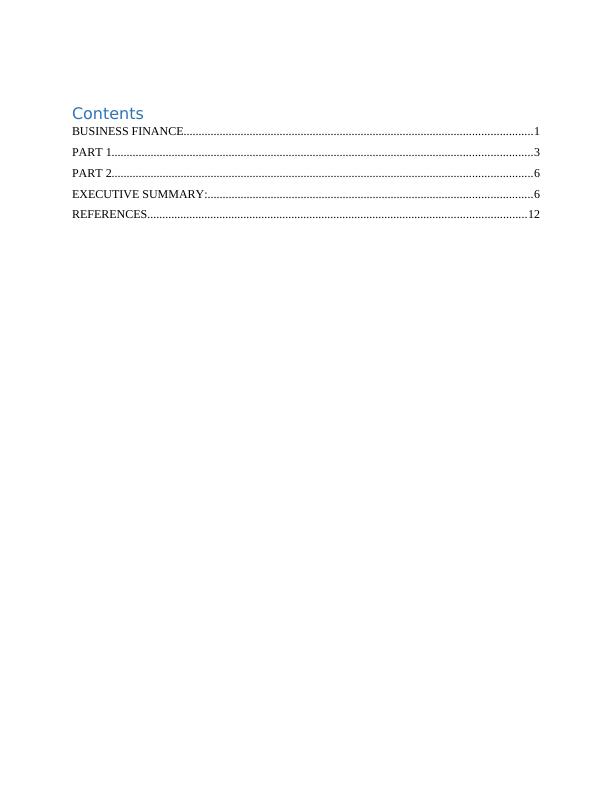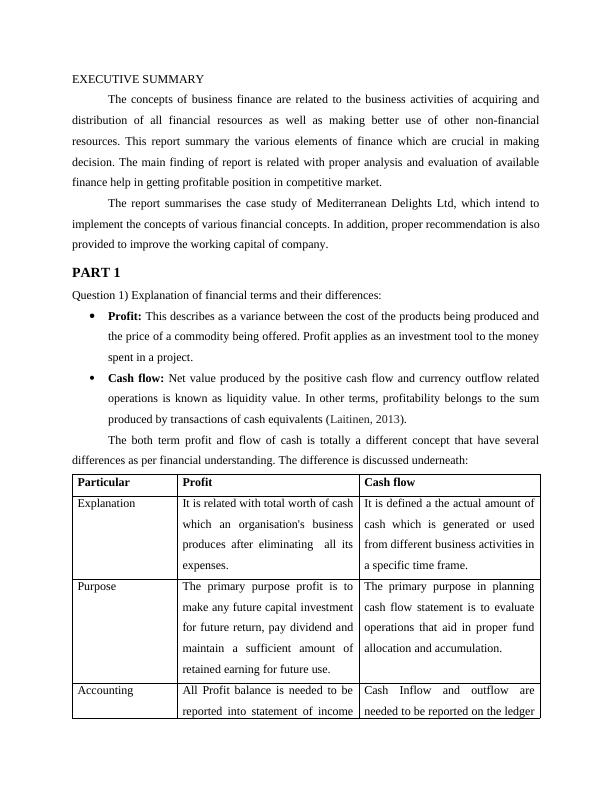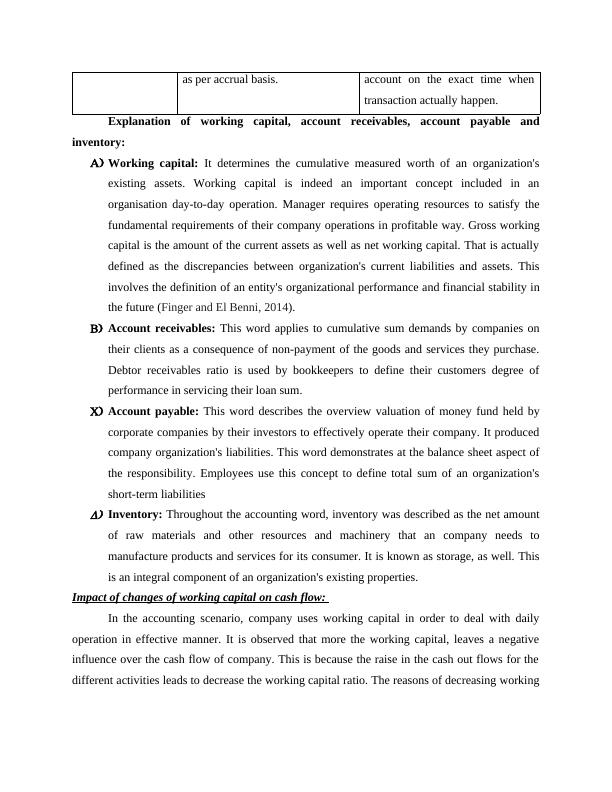Business Finance: Concepts, Analysis, and Recommendations
Added on 2023-01-12
12 Pages3149 Words77 Views
BUSINESS FINANCE

Contents
BUSINESS FINANCE....................................................................................................................1
PART 1............................................................................................................................................3
PART 2............................................................................................................................................6
EXECUTIVE SUMMARY:............................................................................................................6
REFERENCES..............................................................................................................................12
BUSINESS FINANCE....................................................................................................................1
PART 1............................................................................................................................................3
PART 2............................................................................................................................................6
EXECUTIVE SUMMARY:............................................................................................................6
REFERENCES..............................................................................................................................12

EXECUTIVE SUMMARY
The concepts of business finance are related to the business activities of acquiring and
distribution of all financial resources as well as making better use of other non-financial
resources. This report summary the various elements of finance which are crucial in making
decision. The main finding of report is related with proper analysis and evaluation of available
finance help in getting profitable position in competitive market.
The report summarises the case study of Mediterranean Delights Ltd, which intend to
implement the concepts of various financial concepts. In addition, proper recommendation is also
provided to improve the working capital of company.
PART 1
Question 1) Explanation of financial terms and their differences:
Profit: This describes as a variance between the cost of the products being produced and
the price of a commodity being offered. Profit applies as an investment tool to the money
spent in a project.
Cash flow: Net value produced by the positive cash flow and currency outflow related
operations is known as liquidity value. In other terms, profitability belongs to the sum
produced by transactions of cash equivalents (Laitinen, 2013).
The both term profit and flow of cash is totally a different concept that have several
differences as per financial understanding. The difference is discussed underneath:
Particular Profit Cash flow
Explanation It is related with total worth of cash
which an organisation's business
produces after eliminating all its
expenses.
It is defined a the actual amount of
cash which is generated or used
from different business activities in
a specific time frame.
Purpose The primary purpose profit is to
make any future capital investment
for future return, pay dividend and
maintain a sufficient amount of
retained earning for future use.
The primary purpose in planning
cash flow statement is to evaluate
operations that aid in proper fund
allocation and accumulation.
Accounting All Profit balance is needed to be
reported into statement of income
Cash Inflow and outflow are
needed to be reported on the ledger
The concepts of business finance are related to the business activities of acquiring and
distribution of all financial resources as well as making better use of other non-financial
resources. This report summary the various elements of finance which are crucial in making
decision. The main finding of report is related with proper analysis and evaluation of available
finance help in getting profitable position in competitive market.
The report summarises the case study of Mediterranean Delights Ltd, which intend to
implement the concepts of various financial concepts. In addition, proper recommendation is also
provided to improve the working capital of company.
PART 1
Question 1) Explanation of financial terms and their differences:
Profit: This describes as a variance between the cost of the products being produced and
the price of a commodity being offered. Profit applies as an investment tool to the money
spent in a project.
Cash flow: Net value produced by the positive cash flow and currency outflow related
operations is known as liquidity value. In other terms, profitability belongs to the sum
produced by transactions of cash equivalents (Laitinen, 2013).
The both term profit and flow of cash is totally a different concept that have several
differences as per financial understanding. The difference is discussed underneath:
Particular Profit Cash flow
Explanation It is related with total worth of cash
which an organisation's business
produces after eliminating all its
expenses.
It is defined a the actual amount of
cash which is generated or used
from different business activities in
a specific time frame.
Purpose The primary purpose profit is to
make any future capital investment
for future return, pay dividend and
maintain a sufficient amount of
retained earning for future use.
The primary purpose in planning
cash flow statement is to evaluate
operations that aid in proper fund
allocation and accumulation.
Accounting All Profit balance is needed to be
reported into statement of income
Cash Inflow and outflow are
needed to be reported on the ledger

as per accrual basis. account on the exact time when
transaction actually happen.
Explanation of working capital, account receivables, account payable and
inventory:
A) Working capital: It determines the cumulative measured worth of an organization's
existing assets. Working capital is indeed an important concept included in an
organisation day-to-day operation. Manager requires operating resources to satisfy the
fundamental requirements of their company operations in profitable way. Gross working
capital is the amount of the current assets as well as net working capital. That is actually
defined as the discrepancies between organization's current liabilities and assets. This
involves the definition of an entity's organizational performance and financial stability in
the future (Finger and El Benni, 2014).
B) Account receivables: This word applies to cumulative sum demands by companies on
their clients as a consequence of non-payment of the goods and services they purchase.
Debtor receivables ratio is used by bookkeepers to define their customers degree of
performance in servicing their loan sum.
C) Account payable: This word describes the overview valuation of money fund held by
corporate companies by their investors to effectively operate their company. It produced
company organization's liabilities. This word demonstrates at the balance sheet aspect of
the responsibility. Employees use this concept to define total sum of an organization's
short-term liabilitiesD) Inventory: Throughout the accounting word, inventory was described as the net amount
of raw materials and other resources and machinery that an company needs to
manufacture products and services for its consumer. It is known as storage, as well. This
is an integral component of an organization's existing properties.
Impact of changes of working capital on cash flow:
In the accounting scenario, company uses working capital in order to deal with daily
operation in effective manner. It is observed that more the working capital, leaves a negative
influence over the cash flow of company. This is because the raise in the cash out flows for the
different activities leads to decrease the working capital ratio. The reasons of decreasing working
transaction actually happen.
Explanation of working capital, account receivables, account payable and
inventory:
A) Working capital: It determines the cumulative measured worth of an organization's
existing assets. Working capital is indeed an important concept included in an
organisation day-to-day operation. Manager requires operating resources to satisfy the
fundamental requirements of their company operations in profitable way. Gross working
capital is the amount of the current assets as well as net working capital. That is actually
defined as the discrepancies between organization's current liabilities and assets. This
involves the definition of an entity's organizational performance and financial stability in
the future (Finger and El Benni, 2014).
B) Account receivables: This word applies to cumulative sum demands by companies on
their clients as a consequence of non-payment of the goods and services they purchase.
Debtor receivables ratio is used by bookkeepers to define their customers degree of
performance in servicing their loan sum.
C) Account payable: This word describes the overview valuation of money fund held by
corporate companies by their investors to effectively operate their company. It produced
company organization's liabilities. This word demonstrates at the balance sheet aspect of
the responsibility. Employees use this concept to define total sum of an organization's
short-term liabilitiesD) Inventory: Throughout the accounting word, inventory was described as the net amount
of raw materials and other resources and machinery that an company needs to
manufacture products and services for its consumer. It is known as storage, as well. This
is an integral component of an organization's existing properties.
Impact of changes of working capital on cash flow:
In the accounting scenario, company uses working capital in order to deal with daily
operation in effective manner. It is observed that more the working capital, leaves a negative
influence over the cash flow of company. This is because the raise in the cash out flows for the
different activities leads to decrease the working capital ratio. The reasons of decreasing working

End of preview
Want to access all the pages? Upload your documents or become a member.
Related Documents
Business Finance: Working Capital and Cash Flow Analysislg...
|11
|3045
|75
Business Finance: Working Capital and Budgeting Approacheslg...
|11
|3149
|70
Business Finance: Managing Financial Resources for Organizational Successlg...
|12
|2950
|85
Financial Aspects and Budgeting in Businesslg...
|39
|3219
|37
Business Finance: Profit, Cash Flow, and Working Capitallg...
|13
|3489
|64
Budgeting Methods and Their Impact on Second Sight Plclg...
|11
|3226
|52